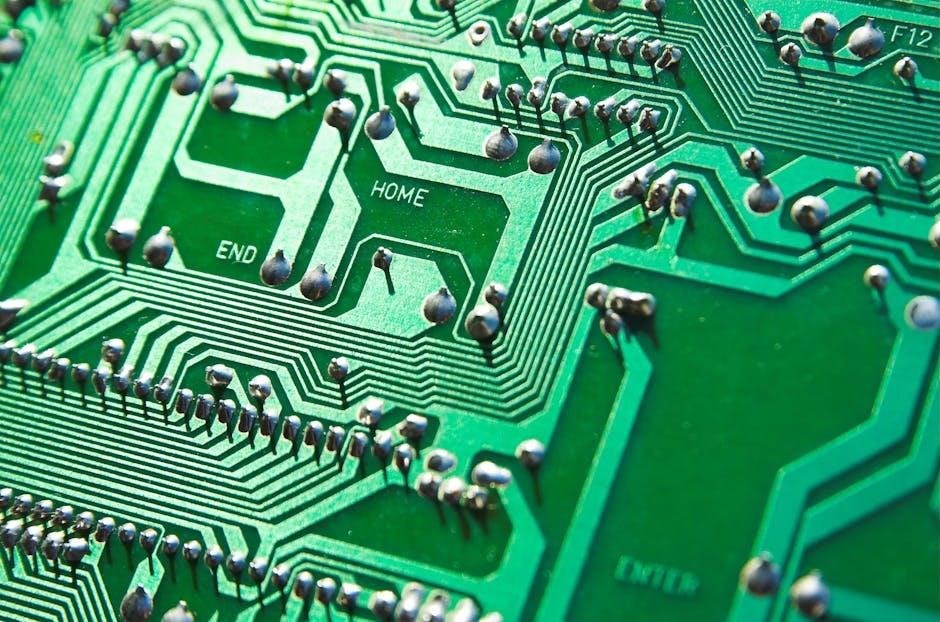dometic ac wiring diagram pdf
A Dometic AC wiring diagram is a visual guide for understanding electrical connections in Dometic air conditioning systems, essential for safe and efficient installations, troubleshooting, and maintenance. It outlines how components like the thermostat, capacitor, and control box interact, ensuring proper system functionality. This resource is invaluable for technicians and DIYers alike, providing clarity on wiring layouts and ensuring compliance with manufacturer specifications for optimal performance and safety.
1.1 What is a Dometic AC Wiring Diagram?
A Dometic AC wiring diagram is a detailed visual guide illustrating the electrical connections and components of a Dometic air conditioning system. It provides a clear layout of how wires are connected to various parts, such as the thermostat, capacitor, control box, and motors. This diagram is essential for understanding the system’s functionality, diagnosing issues, and ensuring proper installations or repairs. It serves as a reference for technicians and DIYers, helping them identify components, trace circuits, and troubleshoot problems efficiently. The wiring diagram is typically included in the unit’s manual or available as a downloadable PDF, making it a vital resource for maintaining and upgrading Dometic AC systems safely and effectively.
1.2 Importance of Wiring Diagrams for Dometic AC Units
A Dometic AC wiring diagram is crucial for ensuring safe and efficient system operations. It provides a clear map of electrical connections, helping technicians and DIYers install, troubleshoot, and maintain AC units effectively. By following the diagram, users can avoid electrical hazards, ensure proper component interactions, and identify potential issues quickly. The diagram also serves as a reference for upgrading or replacing parts, guaranteeing compatibility and optimal performance. Its importance lies in its ability to streamline repairs, reduce downtime, and prevent costly damages, making it an indispensable tool for anyone working with Dometic AC systems. Regular consultation ensures compliance with manufacturer guidelines and enhances overall system reliability and longevity.

Key Components of a Dometic AC Wiring Diagram
The diagram includes essential components like the thermostat, capacitor, control box, and wiring for fan and compressor motors. These elements ensure proper electrical connections and system functionality, making the diagram a vital reference tool.
2.1 Thermostat and Its Role in the Wiring
The thermostat is a critical component in Dometic AC systems, acting as the control center for temperature regulation. It receives power from the control box and activates the fan or cooling mode when needed. The wiring diagram shows how the thermostat connects to the control box, fan motor, and compressor, ensuring seamless communication between these components. Proper wiring of the thermostat is essential to regulate the AC’s operations efficiently, maintaining desired temperatures and system performance. Any issues with the thermostat’s wiring can lead to malfunction, emphasizing the importance of accurate connections as per the diagram. Regular inspection and maintenance are recommended to ensure optimal functionality.
2.2 Capacitor and Its Function in the System
The capacitor plays a vital role in the Dometic AC system, primarily responsible for starting and running the fan and compressor motors. It stores electrical energy, providing the high voltage needed to initiate motor operation. The wiring diagram highlights the capacitor’s connections to the fan and compressor motors, ensuring proper power supply. A faulty capacitor can lead to motor startup issues, such as the fan not spinning, as seen in some cases where users reported needing a replacement. Regular inspection of the capacitor is essential to prevent system malfunctions. The capacitor also helps regulate power surges, ensuring smooth operation and protecting the motor from damage. Proper wiring and maintenance are crucial for optimal performance.
2.3 Relay and Control Box Connections
The relay and control box are central to the Dometic AC system, managing electrical signals and power distribution. The relay acts as a switch, controlling the flow of current to components like the compressor and fan motors. The control box houses the system’s electrical controls, including the thermostat and capacitor connections. The wiring diagram illustrates how the relay is connected to the control box, ensuring signals from the thermostat activate the appropriate components. Proper connections are crucial for safe and efficient operation. Users often report issues when wires are loose or corroded, emphasizing the importance of regular inspections. The relay and control box work together to ensure the AC unit operates smoothly, responding to temperature changes and user settings effectively. Their correct wiring is essential for system reliability and performance.
2.4 Fan and Compressor Motor Wiring
The fan and compressor motor wiring in a Dometic AC system is critical for proper operation. The wiring diagram shows how these motors are connected to the control box and capacitor. The capacitor stores energy to start the compressor and fan motors, ensuring smooth operation. The wiring typically includes high-voltage lines for the compressor and separate connections for the fan motor. Proper wiring ensures the fan runs in sync with the compressor, maintaining airflow and cooling efficiency. Issues like loose connections or faulty capacitors can cause motor failure, highlighting the importance of accurate wiring. Always refer to the official Dometic wiring diagram for specific connections to avoid damage or safety hazards. Regular inspections and maintenance are essential to ensure reliable performance.

Understanding the Thermostat Wiring Schematic
The thermostat wiring schematic explains how power is supplied and distributed to control the Dometic AC system. It details connections for fan and cool modes, ensuring proper operation.

3.1 Power Supply to the Thermostat
The power supply to the thermostat in a Dometic AC system is typically provided by the control box. The 12V supply is activated when the system is switched to fan or cool mode, ensuring the thermostat operates correctly. This power source enables the thermostat to regulate temperature settings and control the AC unit’s functions. It is essential to ensure proper wiring connections to avoid malfunctions. The wiring diagram in the Dometic manual details this connection, highlighting how the control box supplies power only when the system is active. Always refer to the official Dometic documentation for accurate wiring instructions to maintain system performance and safety.
3.2 Connecting the Thermostat to the Control Box
Connecting the thermostat to the control box in a Dometic AC system requires careful attention to wiring diagrams. The thermostat typically connects via a dedicated wiring harness, ensuring proper communication between components. The wires are color-coded, with specific functions assigned to each, such as power supply, temperature sensing, and mode control. It is crucial to match the wires correctly to avoid system malfunctions. The control box serves as the central hub, routing signals to the compressor, fan, and capacitor. Proper connections ensure seamless operation, while incorrect wiring can lead to issues like faulty thermostat responses or system shutdowns. Always refer to the official Dometic wiring diagram for precise instructions.
3.3 Wiring for Fan and Cool Modes
Wiring for fan and cool modes in a Dometic AC system involves connecting specific terminals on the thermostat to the control box. The fan mode is typically controlled by a dedicated wire, allowing the fan to operate independently of the compressor. Cool mode integrates both the fan and compressor, requiring a separate wiring connection to ensure synchronized operation. The wiring diagram specifies which terminals correspond to these modes, ensuring proper electrical flow. Incorrect wiring can result in malfunctioning modes or system shutdowns. Always refer to the official Dometic wiring diagram for accurate connections, as variations may exist between models. Proper wiring ensures efficient operation and prevents potential damage to components.

Dometic AC Installation Instructions
Installation begins with preparing the RV roof, ensuring proper sealing and structural integrity. Route indoor temperature sensors and connect the wiring harness according to the diagram.
4.1 Preparing the RV Roof for Installation
Preparing the RV roof for a Dometic AC installation involves ensuring the surface is level, clean, and structurally sound. Measure the space to confirm it meets the required dimensions, typically a minimum of 1.5 inches and a maximum of 6 inches between the roof and ceiling. Choose a location that avoids obstructions and ensures proper airflow. Seal any existing holes or gaps to prevent leaks and ensure a watertight installation. Remove any debris or old adhesive to create a clean surface for the new unit. Follow manufacturer guidelines for roof preparation to guarantee a secure and efficient installation. Proper preparation ensures the AC unit operates effectively and maintains the integrity of your RV’s roof.
4.2 Routing Indoor Temperature Sensors
Routing indoor temperature sensors for a Dometic AC system requires careful planning to ensure accurate temperature readings and optimal system performance. Begin by locating the sensor in an area that represents the average room temperature, avoiding direct sunlight or drafts. Use the provided wiring harness to connect the sensor to the control box, ensuring connections are secure and not pinched. Follow the manufacturer’s guidelines for routing the sensor wire, typically through the roof opening or a nearby grommet. The 2-pin connector should be securely attached to the roof opening, while the sensor itself is placed indoors. Proper routing prevents damage and ensures reliable temperature sensing, which is crucial for maintaining consistent cooling and energy efficiency.
4.3 Connecting the Wiring Harness
Connecting the wiring harness for a Dometic AC system requires precision to ensure proper functionality. Start by identifying and matching the wires according to the wiring diagram, typically color-coded for clarity. Connect the thermostat wires to the control box, ensuring secure and correct terminal connections. Next, attach the capacitor wires to the designated terminals, and connect the fan and compressor motor wires to their respective points. Use waterproof connectors to protect against moisture, especially in RV installations. Double-check all connections for tightness and inspect for any damage or pinching. Finally, verify the wiring harness is securely fastened to prevent movement during operation. If unsure, consult the official Dometic manual or seek professional assistance to avoid system malfunctions.

Troubleshooting Common Wiring Issues
Common wiring issues in Dometic AC systems include faulty capacitors, thermostat malfunctions, and loose connections. Symptoms like the AC not turning on or the fan not starting often indicate wiring problems. Check for tripped breakers, blown fuses, or corroded connections. Use a multimeter to test for power supply issues or continuity in wires. Consult the wiring diagram to trace and resolve faults efficiently. Always refer to the Dometic manual for specific troubleshooting guidelines to ensure safe and effective repairs.
5.1 Identifying Faulty Capacitors
A faulty capacitor is a common issue in Dometic AC systems, often causing the fan or compressor to fail to start. Symptoms include the motor not spinning or requiring a manual “spin-start.” Inspect the capacitor for visible signs of damage, such as swelling, leaking, or rust. Use a multimeter to test the capacitor’s capacitance, comparing it to the value specified in the wiring diagram. If the reading is incorrect, the capacitor must be replaced. Always disconnect power before testing or replacing the capacitor to avoid electrical shock. Refer to the Dometic manual for the correct replacement type and installation procedures. A faulty capacitor can lead to system failure if not addressed promptly.
5.2 Diagnosing Thermostat Malfunctions
Thermostat malfunctions can disrupt Dometic AC operations, causing temperature control issues. Check the wiring connections between the thermostat and control box for looseness or corrosion. Ensure the thermostat is receiving power, as indicated in the wiring diagram. A faulty thermostat may not send the correct signals to the control box, preventing the fan or compressor from activating. Test the thermostat’s functionality by bypassing it temporarily if the system allows. If the system operates without the thermostat, it confirms the thermostat is faulty and needs replacement. Always refer to the Dometic wiring diagram to verify connections and ensure compatibility with the new thermostat. Proper diagnosis is key to restoring accurate temperature control and system efficiency.
5.3 Fixing Loose or Corroded Connections
Loose or corroded connections are common issues in Dometic AC wiring. Regularly inspect connectors and terminals for signs of wear or corrosion. Use a multimeter to test for continuity and ensure proper electrical flow. Clean corroded connections with a wire brush or replace them if damage is severe. Tighten loose connections firmly but avoid over-tightening, which can damage threads. Always refer to the wiring diagram to verify the correct connections. Apply silicone-based electrical spray to protect cleaned or new connections from future corrosion. If unsure, consult a professional to avoid further damage or safety risks. Properly secured and clean connections are essential for reliable system performance and safety.

Safety Precautions for Wiring Diagrams
Always disconnect power before working on wiring to prevent electrical shocks. Use proper tools and protective gear when handling live circuits or high-voltage components. Ensure all connections are secure to avoid short circuits and potential fires. Follow manufacturer guidelines and safety standards to prevent accidents. Never attempt repairs without proper knowledge or training. Regularly inspect wiring for damage or wear to maintain system safety and efficiency. Adhere to grounding procedures to ensure safe operation of your Dometic AC unit. Safety should always be the top priority when working with electrical systems.
6.1 Working with 12V and 120V Systems
When working with Dometic AC wiring diagrams, it’s crucial to distinguish between 12V and 120V systems. The 12V system typically powers control circuits, such as the thermostat and electronic components, while the 120V system handles higher power demands for motors and compressors. Always verify the voltage rating of each component to avoid damage or electrical hazards. Use appropriate tools and ensure the power supply is disconnected before starting any work. Mixing voltages can lead to system malfunctions or safety risks. Refer to the wiring diagram to identify specific voltage requirements for each part of the system. Proper handling of both voltage systems ensures safe and efficient operation of your Dometic AC unit.
6.2 Proper Use of Tools and Protective Gear
Working with Dometic AC wiring requires the proper use of tools and protective gear to ensure safety and efficiency. Always use insulated screwdrivers, pliers, and multimeters to handle electrical components. Safety glasses and gloves are essential to protect against electrical shocks or arc flashes. Ensure all power sources are disconnected before starting work, as live circuits can pose severe risks. Use a wiring diagram to identify components and connections accurately. Proper tools prevent damage to wiring and components, while protective gear safeguards against accidents. Regularly inspect tools and gear for wear or damage to maintain reliability. Adhering to these practices ensures a safe working environment when troubleshooting or installing Dometic AC systems.

Dometic AC Maintenance and Upkeep
Regular maintenance ensures optimal performance. Clean condenser coils annually and inspect wiring for damage or corrosion. Neglecting these steps can lead to reduced efficiency or system failure.
7.1 Cleaning the Condenser Coils
Cleaning the condenser coils is a critical maintenance task for Dometic AC systems. Dirt and debris buildup can reduce efficiency and cause overheating. Use a garden hose with moderate pressure to rinse the coils, ensuring no water enters electrical components. Avoid harsh chemicals or abrasive tools, as they may damage the coils. For stubborn dirt, a soft-bristle brush can gently remove particles. Regular cleaning maintains proper airflow and heat transfer, ensuring optimal performance. Additionally, inspect the drain line for blockages to prevent water accumulation, which can lead to system damage. Perform this maintenance at least once a year, or more frequently in dusty environments, to keep your Dometic AC running smoothly and efficiently.
7.2 Inspecting Wiring for Damage
Inspecting the wiring for damage is essential to ensure the safe and efficient operation of your Dometic AC system. Begin by disconnecting the power supply to avoid electrical hazards. Visually examine the wiring harness for signs of wear, fraying, or corrosion. Check for loose or corroded connections, which can cause malfunctions. Use a multimeter to test for continuity and identify any breaks in the circuit. Pay special attention to areas near moving parts or high-temperature components, as these are prone to damage. Replace any damaged wires or connectors promptly to prevent system failures. Regular inspections help maintain reliability and prevent costly repairs, ensuring your Dometic AC operates at peak performance.

Advanced Wiring Tips for Dometic AC Units
Advanced wiring tips for Dometic AC units include upgrading to smart thermostats for enhanced control and installing soft-start capacitors to reduce motor strain and improve efficiency.
8.1 Upgrading to a Smart Thermostat
Upgrading to a smart thermostat enhances your Dometic AC system’s functionality, offering remote control, programmable settings, and energy-saving features. Ensure compatibility with your unit by checking the wiring diagram for the correct connections. Smart thermostats often require additional wiring for Wi-Fi or Bluetooth capabilities, so consult the manual or manufacturer’s guide. This upgrade can optimize performance, reduce energy consumption, and provide real-time monitoring, making it a valuable improvement for modern RVs. Always disconnect power before starting the installation to avoid electrical hazards.
8.2 Adding a Soft Start Capacitor
Adding a soft start capacitor to your Dometic AC unit can help reduce high inrush current during compressor startup, minimizing voltage drops and potential circuit breaker trips. This upgrade is particularly beneficial for RVs with limited power capacity. To install, locate the capacitor in the wiring diagram, ensuring compatibility with your system. Typically, the capacitor is near the compressor or control box. Use a soft start kit designed for your unit, following the manufacturer’s instructions. Disconnect power before starting to avoid electrical hazards. Proper installation can lead to smoother compressor operation and improved overall efficiency, enhancing your AC system’s performance and longevity.

Manufacturer Resources and Documentation
Dometic provides official manuals, wiring diagrams, and installation guides on their website, ensuring access to accurate and up-to-date information for technicians and users. Visit www.dometic.com to download resources specific to your AC model, aiding in safe and efficient system setups and repairs.
9.1 Accessing the Official Dometic Manual
To access the official Dometic manual, visit the Dometic website at www.dometic.com. Navigate to the “Support” or “Downloads” section, where you can search for your specific AC model. Enter keywords like “wiring diagram” or your unit’s model number to find the relevant documentation. The manual provides detailed wiring diagrams, installation guides, and troubleshooting tips. It also covers safety precautions, maintenance schedules, and technical specifications. Ensure you have your product’s serial number or model number handy for accurate results. This resource is essential for anyone working with Dometic AC systems, offering comprehensive guidance for installations, repairs, and routine upkeep.
9.2 Finding the Latest Installation Guides
To find the latest installation guides for your Dometic AC, visit the official Dometic website and navigate to the “Support” or “Resources” section. Use the search bar to enter your AC model number or keywords like “installation guide” or “wiring diagram.” Ensure you select the most recent version, as updates often include improved instructions and safety measures. Additionally, Dometic provides downloadable PDF manuals, which are accessible after entering your product details. For further assistance, refer to the Dometic forum or contact authorized dealers, as they often host updated documentation. Always verify the guide’s version matches your unit to avoid compatibility issues. Regularly check for updates to stay informed about new features or installation requirements.
A Dometic AC wiring diagram is a crucial tool for safe and efficient RV air conditioner installation, troubleshooting, and maintenance. Always refer to official guides and manufacturer resources for accuracy and compliance.
10.1 Summary of Key Points
A Dometic AC wiring diagram is essential for understanding and working with air conditioning systems in RVs. It provides a clear visual representation of electrical connections, ensuring safe and efficient installations. Key components such as the thermostat, capacitor, and control box are highlighted, along with their roles in system operation. Proper wiring practices, troubleshooting techniques, and maintenance tips are emphasized to prevent issues like faulty capacitors or loose connections. Consulting official manufacturer resources and following safety guidelines are crucial for optimal performance and longevity of the system. By adhering to these principles, users can ensure their Dometic AC operates reliably and efficiently, minimizing downtime and enhancing overall comfort.
10.2 Final Tips for Working with Dometic AC Wiring
Always refer to the official Dometic AC wiring diagram specific to your model for accurate guidance. Ensure the power is off before starting any work, using a voltage tester to confirm. Wear protective gear, like insulated gloves, to prevent electrical shocks. Familiarize yourself with the diagram’s symbols and components, such as the thermostat, capacitor, and control box. Use tools like multimeters to test for issues and pinpoint faults. Regularly inspect wiring for damage or corrosion and address problems promptly. Consider upgrading to smart thermostats or soft start capacitors for improved efficiency, but only after understanding the necessary wiring changes. Consult the Dometic manual and seek professional help if unsure. By following these tips, you can ensure safe and effective work on your Dometic AC wiring, maintaining optimal performance and longevity.


